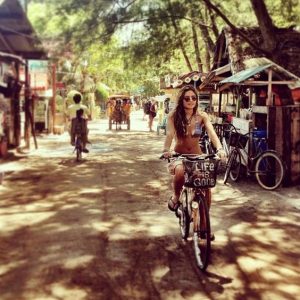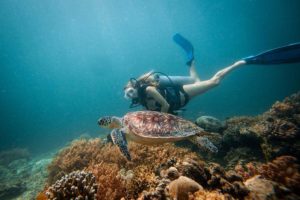
BOOKING YOUR TICKET NOW!
SPECIAL OFFER 45% OFF
PROMO
CODE
NEWBOAT
BOOK PERIOD UNTIL APRIL 30TH, 2025
TRIP PERIOD 1-31 MAY, 2025
About Gili’s. Just a short two hour boat trip from Bali are the Gili Islands of Trawangan, Meno and Air. The largest of the three islands, Gili Trawangan, is around thirty minutes boat ride from the northwest mainland of Lombok and attracts the majority of visitors. The beaches of the Gilis are still powdery white, the water a beautiful clear blue and they are positioned perfectly for sunsets over Bali’s Mt Agung and sunrise over Lombok’s Mt Rinjani.

Thirty years ago the islands were uninhabited and only discovered by the seafaring Bugis people from Sulawesi. It was only a matter of time before the more adventurous backpacker types discovered the islands and developed Trawangan into a hippy party paradise.
Gili Trawangan
Gili Trawangan now identifies itself as a great destination suitable for families of all ages. Various new hotels, luxury villas, and boutique bungalows now cater to children and offer good value. Some have baby-sitting services, and with lots of activities on the islands families are sure to enjoy their holidays to the full.
There are many restaurants on the islands with a choice of cuisines ranging from traditional warung style Indonesian food to all types of international menus. Many restaurants offer beachfront barbeques selling fresh fish, prawns and lobster – there is even a Spanish Tapas bar, Indian restaurant, sushi bar and an Irish bar!
Gili Meno
Only a kilometre from Gili Trawangan and set in the middle of the three islets lies the real Robinson Crusoe experience of the Gilis with some of the best beaches to be found. Only two kilometres long and one in width, Gili Meno is the smallest of the three islands and by far the most tranquil. Most visitors are drawn to Meno for the lure of total escapism and it is therefore very popular with honeymooning couples and adventurous castaway types.
The dining scene is predominantly warung fare with grilled fishon the beach once dusk approaches. Lazing around in a hammock,reading books and playing chess with the friendly locals (who arealways willing to strike up a conversation) also ranks very highly on the daily Meno agenda. For divers and snorkellers, the island boasts the infamous Gili Meno Wall where during the day turtles freely swim by and giant gorgonian fans hang amongst the colourful corals. At night divers can witness huge Moray Eels and the entertaining Spanish Dancers.
Gili Air
Although Gili Air is closest to the Lombok mainland it is the most overlooked of the three islands in terms of development. However, that is all set to change as the market here is geared very much towards the budget traveller and tropical island explorer. A lot of visitors actually prefer the grass roots atmosphere of Gili Air and the feeling of really being part of a close knit local community.
The circumference of the island is traversable by foot in around two and a half hours but be sure to pack some supplies as you’re heading well off the beaten track. As with Gili Meno the pace of life is slow and endearing to those who really want to escape the hustle and bustle of the outside world. More accommodation, cafés and bars are slowly starting to spring up to compliment the three dive centres on the main beach strip.
There are internet facilities at the Ozzy Shop (who also rent bicycles) and in a tiny wartel (phone shop) behind Villa Karang the connection is far from reliable. For its size Gili Air actually has awide range of accommodation to suit every taste and budget either on the beach or set back in the coconut groves. Be advised to change enough cash for your entire stay as the nearest moneychanger and ATM is on Gili Trawangan.
GETTING THERE
Regular daily fast boats depart Bali from Benoa Harbour in the south and Padang Bali in the east, directly to Gili Trawangan and Gili Air. All boats stop off at Teluk Nare on mainland Lombok as part of the return journey back to Bali. Public ferries run every two hours between Padang Bai and Lembar in Lombok and take around five hours. Bemos can take you to Bangsal Harbor on Lombok where public shuttle boats leave frequently to all three Gili islands. Perama shuttle buses leave every day from all major destinations in Bali. Their traditional Phinisi boat also leaves from Padang Bai harbor at 13.30, arriving in Gili at around 18.00.
There are regular daily flights from Denpasar to Mataram leaving throughout the day providing another degree of flexibility for those who don’t possess sea legs. Flight time clocks in at only twenty minutes from Bali to Lombok. Airport transfers with a car and speedboat can be arranged and only take about one hour to the islands.

ISLAND LIFE
There are a variety of activities on all three islands – the most popular of which being beachcombing, or pitching up a hammock and soaking up the tropical ambience of the Gilis! It’s possible to follow the beaches around the perimeter of the islands in only about two hours on foot. There are two turtle sanctuaries on the Gilis as well as a birdpark, horse riding at the local stables, sunrise yoga classes on the beach, sunset drinks at the bar overlooking Mount Agung and kayaking trips inbetween!
There are three turtle sanctuaries on the Gilis as well as a birdpark, horse riding at the local stables, sunrise yoga classes on the beach, sunset drinks at the bar overlooking Mount Agung and kayaking trips inbetween!
Turtle Sanctuary (in front of Dino Café, main beach Trawangan) is involved in the preservation of one of Indonesia’s most endangered naturalspecies. The turtle eggs are purchased from collectors and put insecure incubation areas until hatching, whereupon they are placed in holding tanks. When the turtles are large and healthy enough they are released. The most popular activities on the Gilis are centered around watersports. There are a handful of surf breaks scattered throughout the islands but the main draw is the year round quality diving and snorkeling. All dive centres and many shack operations lining the beaches rent snorkelling equipment for around IDR 50,000 for half a day.
Diving

With over twenty-five dive sites surrounding all three islands there are opportunities to dive any of the Gilis regardless of where you base yourself. Most visitors stay on Gili Trawangan for the facilities and make the short hop out to the dive sites. Each dive school has its own fleet of traditional outrigger boats that ferry divers offshore to the walls and reefs where the best diving is to be found.
There’s a high standard of multilingual PADI, SSI and TDI certified (both local and foreign) dive instructors and guides working in the centres who have a vast knowledge of the region and know exactly where and when to take visitors to maximise their Gili scuba experience. Visability is consistently good all year round with an average distance of thirty metres. Divers can expect to see a range of topography, a large
variety of hard and soft corals and a spectacular diversity of marine life unique to Indonesia. The two most popular dive sites are Shark Point and Manta Point where divers can expect to spot black and white tip reef sharks, varieties of turtles, rays and hundreds of indigenous species.